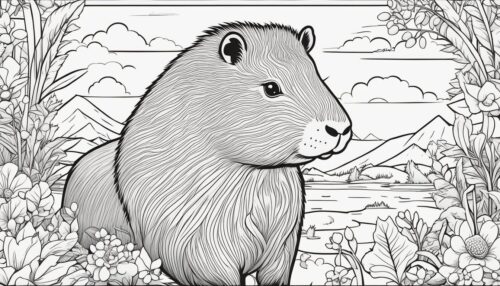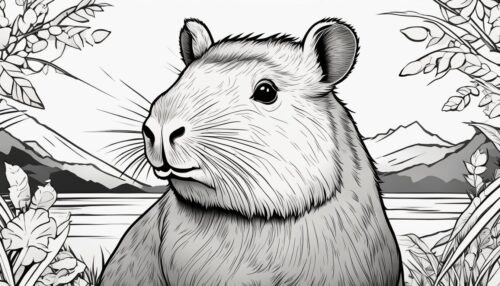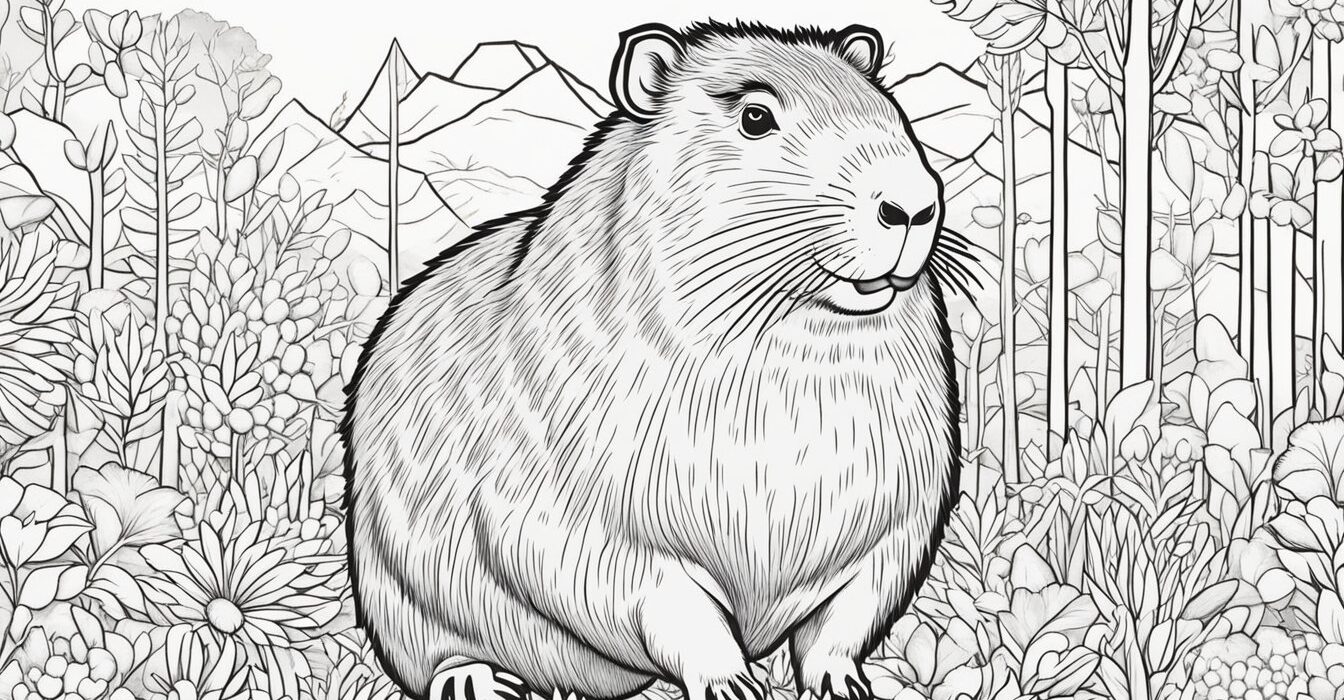Capybara Coloring Pages: Fun Activities for Kids and Adults. Capybara coloring pages offer a delightful way for individuals of all ages to express their creativity. These printable sheets cater to both children and adults, featuring a variety of designs that capture the charm of these sociable animals. Engaging with capybara coloring pages not only promotes relaxation but also enhances fine motor skills and color recognition in young learners while providing a creative outlet for older enthusiasts.
Capybara Coloring Pages





For families seeking enjoyable activities, capybara coloring pages can serve as an excellent bonding experience. Children can immerse themselves in the serene world of capybaras, using different colors to bring the illustrations to life. Adults can join in as well, gaining a moment of tranquility amid their busy schedules by embracing the calming nature of coloring.
With numerous free and printable options available, accessing these coloring pages is convenient and fun. Whether coloring alone or with family and friends, everyone can appreciate the unique and friendly characteristics of capybaras while tapping into their artistic side.
Understanding Capybaras




Capybaras are fascinating creatures known for their unique traits and social behavior. These large rodents are native to South America and thrive in diverse habitats. This section explores their classification as the largest rodent in the world, their natural environments, and their distinct physical features.
The Largest Rodent in the World
The capybara holds the title of the largest rodent globally, with adult individuals typically weighing between 77 to 146 pounds. They can reach lengths of up to 4 feet and stand about 2 feet tall at the shoulder. Capybaras are remarkable for their sociable nature, often forming groups that can include up to 100 individuals. These herds provide security and facilitate social bonding among members. Their size and social structure contribute to their status in the animal kingdom. Pompeii
Natural Habitat and Social Behavior
Capybaras are adaptable and can be found in various habitats across South America, including rivers, ponds, forests, and meadows. They prefer areas near water sources, which provide food and essential protection from predators. They are semi-aquatic animals, capable of swimming effortlessly thanks to their webbed feet.
Socially, they are gregarious creatures that thrive in groups, which can consist of both family units and larger aggregations. Their social behavior helps with foraging and offers safety in numbers, allowing them to stay alert for threats while they graze on aquatic plants and grass.
Physical Characteristics
Capybaras exhibit several distinct physical traits. Their bodies are robust and barrel-shaped, covered in coarse fur that ranges from shades of brown to light brown. This coloration allows them to blend seamlessly into their natural surroundings.
They possess large, expressive eyes and a short, blunt snout that gives them an endearing appearance. Their teeth continue to grow throughout their lives, which necessitates constant gnawing on vegetation to keep them worn down. Additionally, their webbed feet facilitate swimming, enhancing their skills as swimmers. Capybaras are well-adapted to their environments, making them unique among rodents.
Capybaras and Their Ecosystem



Capybaras play a vital role in their ecosystem, particularly in South American habitats such as forests and riverbanks. Their interactions with other animals and their ability to thrive in aquatic environments significantly influence the surrounding biodiversity.
Interactions with Other Animals
Capybaras are social creatures that often live in groups. These groups may range from 10 to 20 individuals but can be larger in suitable environments. They coexist with a variety of species, including birds, monkeys, and even predators like jaguars.
The presence of capybaras attracts birds, such as egrets and herons, that benefit from the insects disturbed by the capybaras’ grazing activities. Their grazing also helps control vegetation, creating a balanced habitat that supports diverse flora and fauna. Additionally, capybaras have mutualistic relationships with other animals, as they may provide a source of food or a safe resting place for smaller creatures.
Capybaras in the Water
Capybaras are excellent swimmers, demonstrating remarkable adaptations for aquatic life. They possess webbed feet that aid in swimming, enabling them to navigate swiftly through rivers and streams. This ability is crucial, as they often seek refuge in water when threatened by predators, such as jaguars or caymans.
Living near water bodies, capybaras play an essential role in maintaining the health of rivers by consuming excessive aquatic plants. Their activities help prevent overgrowth, which can lead to reduced oxygen levels in water. Moreover, their presence enhances the ecosystem by providing food sources for many aquatic birds and mammals, establishing a connected web of life in their forest and river habitats.
Coloring Pages: A Doorway to Creativity
Coloring pages provide a unique opportunity to express creativity across various age groups. With engaging designs, such as capybara illustrations, they encourage individuals to explore different techniques and materials while enjoying the artistic process.
Benefits of Coloring for All Ages
Coloring offers numerous benefits for both children and adults. For children, it enhances fine motor skills and hand-eye coordination. Engaging in this creative activity helps with focus and concentration, allowing young artists to practice patience.
Adults also find coloring therapeutic. It serves as a form of stress relief, promoting relaxation and mindfulness. This creative outlet allows adults to escape from daily pressures while fostering self-expression. Studies suggest that engaging in coloring can lead to a meditative state, boosting overall well-being.
Choosing the Right Materials
Selecting the right materials is vital for an enjoyable coloring experience. Paper quality matters; thicker paper can prevent bleed-through from ink or markers. Additionally, various tools can be used, including crayons, colored pencils, and markers.
Each tool offers a different texture and coloring technique. For instance, markers provide vibrant colors but might bleed through thinner paper. Colored pencils allow for intricacy and blending, while crayons are great for young children due to their ease of use. Individuals should choose materials that align with their preferences and skill levels for the best results.
Capybara Coloring Page Resources



When exploring capybara coloring pages, individuals have various options for engaging with these delightful images. Resources available cover both printable formats and digital tools, as well as guides for enhancing the coloring experience.
Printable Pages vs. Digital Coloring
Printable capybara coloring pages are often available in PDF format. They can be easily downloaded, printed, and colored with traditional materials like crayons, markers, or colored pencils. This method allows for tactile interaction and offers a satisfying experience, especially for younger artists.
Digital coloring pages provide an alternative that many find appealing for convenience. By downloading files, users can color using popular apps such as Procreate or Adobe Fresco. These apps often feature tools for layering colors, blending, and undoing mistakes. Digital files typically allow for infinite prints, making them a practical choice for those who want to explore different coloring techniques without using physical materials.
Guides and Techniques for Coloring
To enhance the coloring experience, a range of guides and techniques can be utilized. Beginners may benefit from basic color theory, which helps in selecting harmonious shades. For instance, using complementary colors can create vibrant visuals.
More advanced artists can explore techniques such as shading and highlighting to add depth to their work. This can be achieved by layering colors, starting with lighter shades and gradually adding darker tones. Tutorials on digital platforms may cover these techniques in detail, making it easier for artists to implement them.
Capybara coloring pages offer endless opportunities for creativity. Whether choosing printable sheets or digital options, individuals can enjoy a fulfilling and artistic pastime. Happy coloring!



